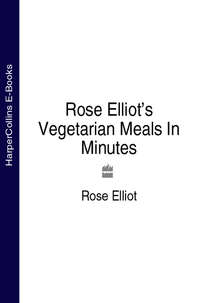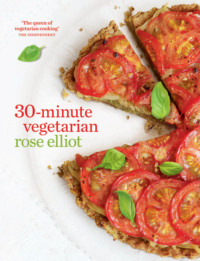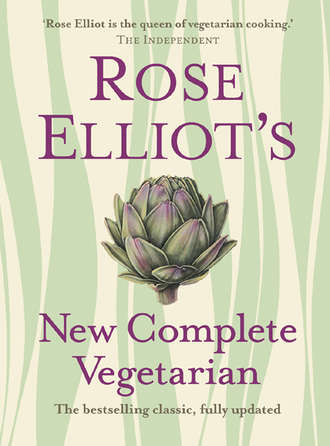
Полная версия
Rose Elliot’s New Complete Vegetarian
SERVES 4

2 tbsp olive oil
1 large onion, chopped
1 stick of celery, chopped
8 sprigs of fresh mint
125g (4oz) green split peas
1 litre (1¾ pints) unsalted stock
a pinch of ground cloves
1 bay leaf
salt and freshly ground black pepper
single cream or crème fraîche, or mint sprigs, to garnish
Heat the oil in a large saucepan, add the onion and celery and fry gently, without browning, for about 10 minutes.
Meanwhile remove the leaves from the stems of the mint and set aside. Add the stalks to the saucepan, together with the split peas, stock, ground cloves and bay leaf.
Bring to the boil, half covered with a lid, and simmer for about 40 minutes or until the split peas are tender.
Remove the bay leaf and mint stalks, add the mint leaves and blend until smooth and creamy, then season with salt and pepper.
Cool then chill the soup in the fridge. Check the seasoning again before serving, then ladle into individual bowls and top with a spoonful of crème fraîche or cream, or a fresh mint sprig, or both.
Yellow split pea soup v
Normally I don’t add any thickening to a lentil or split pea soup; they have enough body without. However, this soup is an exception. The split peas are cooked, puréed, then stirred into a roux of butter and flour, just like making a sauce. The result is a particularly smooth and creamy texture and buttery flavour.
SERVES 4-6

225g (8oz) yellow split peas
1.7 litres (3 pints) water or unsalted vegetable stock
25g (1oz) butter or pure vegetable margarine
1 large onion, chopped
1 garlic clove, crushed
25g (1oz) flour (I use fine wholemeal)
salt and freshly ground black pepper
Put the split peas into a large saucepan with the liquid, bring to the boil and simmer gently for 40–50 minutes or until tender. You need a large pan for this because of the bubbling water. If this is a problem, try adding a little oil to the cooking water, or cook the peas using only 1.2 litres (2 pints) of water and add the rest when you blend the soup.
Blend the split peas until smooth and transfer to a bowl.
Melt the butter in the rinsed-out saucepan and fry the onion until golden. Stir in the garlic and flour, cook for a minute or two, then gradually pour in the split pea purée, stirring until you have a smooth mixture.
Let the soup simmer for 5–10 minutes to cook the flour, then season and serve.
Sweetcorn soup
A pretty, pale golden soup with a hint of sweetness. You can blend it until it’s smooth, and then strain it too if you want it really delicate and silky; or half-blend it, leaving some pieces of sweetcorn for texture. You will need 2–3 sweetcorn cobs for this quantity of kernels, or you could use frozen kernels, which work well too.
SERVES 4

1 onion, chopped
1 tbsp of olive oil
15g (½oz) butter
225g (8oz) sweetcorn kernels, frozen or cut from the cob
700ml (1¼ pints) water
150ml (5fl oz) single cream
a pinch or two of paprika, to taste, plus extra for garnishing
a squeeze of lemon juice
salt and freshly ground black pepper
In a large saucepan, fry the onion in the oil and butter, covered, for 10 minutes. Don’t let the onion brown.
Add the sweetcorn and water, bring to the boil, then reduce the heat and simmer for 10–15 minutes.
Blend the soup until it is the texture you want, then stir in the cream, paprika and a little lemon juice, plus salt and pepper to taste.
Reheat gently, without boiling, and sprinkle a dusting of paprika pepper on top.
Tomato and fresh basil soup with cream
When it’s made in the summer with just-picked tomatoes and fragrant fresh basil, this has to be one of the best soups of all, but even canned tomatoes give a very acceptable result as long as you a choose good quality brands.
SERVES 4-6

1 tbsp olive oil
25g (½oz) butter
1 onion, chopped
350g (12oz) potatoes, peeled and cut into even-sized chunks
450g (1lb) tomatoes, chopped
1.2 litres (2 pints) light vegetable stock or water
salt and freshly ground black pepper
sugar (optional)
TO GARNISH
150ml (5fl oz) single cream
2 tbsp torn fresh basil leaves
Heat the butter and oil in a large saucepan and add the onion. Fry for 5–7 minutes, covered, until fairly soft but not browned.
Add the potatoes, stir, cover and cook for a further 5–10 minutes. Cover the pan but stir often to prevent sticking.
Add the tomatoes and the stock or water. Bring to the boil, then simmer, covered, for about 15 minutes or until the potatoes are very tender.
Blend thoroughly then pour the soup through a sieve into a clean saucepan to remove the seeds and skins of the tomatoes.
Taste and season with salt, pepper and a pinch or two of sugar if you think it needs it. Reheat and serve each bowl topped with a generous spoonful of cream and some basil.
Clear vegetable broth v
The better the stock, the better this soup will be. Homemade stock is great, if you have it, but if not, good-quality vegetable bouillon powder or stock concentrate will also work well.
SERVES 4
2 sticks of celery, chopped
2 onions, chopped
2 carrots, diced
other vegetables as available (e.g. a few French beans or a little cabbage)
2 tsp olive oil
1 tsp yeast extract
1 tsp tomato purée
1 bay leaf
850ml (1½ pints) vegetable stock
salt and freshly ground black pepper
2 tbsp chopped fresh chives, to garnish
Fry the celery, onion and carrot together in the oil without browning for 5 minutes.
Add the beans, broken into short lengths, and the cabbage, shredded. Cook over a gentle heat for a further 5 minutes. Cover the pan but stir often.
Add the yeast extract, tomato purée, bay leaf and stock, bring to the boil and simmer for 20–30 minutes.
Season with salt and freshly ground black pepper. Sprinkle with the chopped chives before serving.
VARIATION
Clear mushroom broth v
Mushrooms make a delightful broth. You can use any type – field, portobello, shiitake or delicate little button mushrooms. Leave out the carrots and other vegetables, and add 225g (8oz) sliced or chopped mushrooms to the onions and celery after they have been frying for 5 minutes. Pour in the stock, bring the boil and simmer for 10–15 minutes, then stir in 2 heaped tablespoons of chopped flat-leaf parsley before serving.
Creamy white bean soup with truffle oil v
This silky-smooth soup is very easy to prepare and a sure-fire hit with everyone. The swirl of truffle oil on the top makes it luxurious enough for a special occasion.
SERVES 4
2 x 400g cans haricot or cannellini beans or 200g (7oz) soaked and cooked until very tender
2 tbsp olive oil
1 onion, chopped
2 garlic cloves, crushed
1 tsp vegetable bouillon powder or a stock cube
salt and freshly ground black pepper
TO GARNISH
a little chopped fresh parsley
4 tsp truffle oil
Drain the beans, reserving the liquid if you are using ones you have cooked yourself.
Heat the olive oil in a large saucepan, add the onion, cover with a lid and cook gently, stirring occasionally, for 10 minutes or until the onion is soft but not brown.
Stir in the garlic and cook for a few seconds, then add the drained beans. Make the drained liquid from the beans up to 850ml (1½ pints) with water, or just use water and add to the pan, along with the bouillon powder or stock cube. Bring to the boil, then simmer, uncovered, for 10 minutes.
Blend the soup thoroughly until it is really smooth and creamy. Season to taste with salt and pepper.
Serve in bowls with a little finely chopped parsley, a grinding of pepper and a swirl of truffle oil.
Winter vegetable soup
A pale golden soup, full of flavour, and it couldn’t be easier to make. Try a big, steaming bowl of it on a winter’s day, with chunks of crusty bread.
SERVES 4

1.2 litres (2 pints) water
2 fairly large carrots
2 onions
2 potatoes
1 swede (about 225g (8oz))
1 turnip (about 225g (8oz))
4 sticks of celery
15g (½oz) butter
salt and freshly ground black pepper
Pour the water into a large saucepan and bring to the boil while you prepare the vegetables. Peel and cut them into fairly small chunks, then add them to the water, together with some salt, and simmer gently, covered, for about 30 minutes or until they’re tender.
Blend the soup to the smoothness you want, and stir in the butter. Season to taste, then reheat and serve.
Vichyssoise
This classic chilled summer soup is always popular.
SERVES 6

1 onion, chopped
1 tbsp olive oil
15g (½oz) butter
225g (8oz) potatoes, peeled and diced
700g (1½lb) leeks, sliced
575ml (1 pint) water
salt
575ml (1 pint) milk
freshly ground black pepper
150ml (5fl oz) single cream
2 tbsp chopped chives, to garnish
Fry the onion in the oil and butter for about 5 minutes in a large, covered saucepan but don’t let it brown.
Add the potatoes and leeks and stir until they’re coated glossy with the oil. Put the lid back on the pan, turn the heat right down and cook gently for a further 15 minutes, stirring from time to time and being careful not to let it brown.
Stir in the water and a little salt and bring to the boil, then cover and leave to simmer for 20–30 minutes or until the vegetables are tender.
Purée the soup very thoroughly, adding some of the milk if you like, to make the process easier. Tip the soup into a bowl or jug – pouring it in through a sieve if you want the soup really velvety – and add the remaining milk. Taste and season the soup, then chill it.
Taste the soup again before serving, then spoon some cream over the top of each bowlful. Sprinkle with the chopped chives and serve.
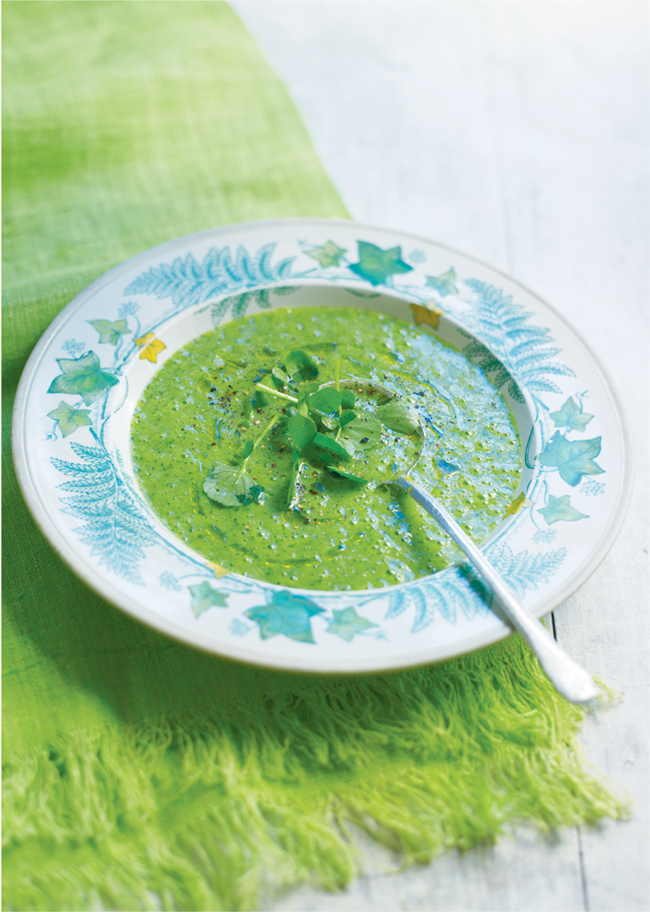
Watercress soup
This is my family’s favourite soup and the one I get the most requests to make.
SERVES 4-6

900g (2lb) potatoes, peeled
3 tbsp olive oil
salt
2 litres (3 pints) light vegetable stock or water
vegetable bouillon powder or a stock cube
1 packet of fresh watercress
freshly ground black pepper
Slice the potatoes as thinly as you can; this is to help them soften quickly in the oil.
Heat the oil in a large saucepan and add the potato slices with a sprinkling of salt, which also helps the softening process by drawing the water out of the potatoes. Cook very gently, covered, for 5–15 minutes, stirring often. The longer you can let them ‘sweat’ like this, the better the soup. They can get flecked with some gold, but don’t let them brown because that will spoil the flavour. Add 1–2 tablespoons of water if they start to stick.
Add three-quarters of the stock or water and the bouillon powder or stock cube. Bring to the boil, cover and simmer gently for 5–15 minutes or until the potatoes are soft. The timing will depend on how long you sweated the potato for if you got it very tender, this stage will take hardly any time.
Reserve some small sprigs of watercress for garnishing (one for each bowl), and add the rest to the soup. Blend thoroughly to a smooth, bright green cream. Adjust the consistency with the remaining water to get it to the consistency you like.
Season with salt and pepper (you may not need much salt, if any). Reheat and serve with watercress leaves and a grinding of black pepper on each bowlful.
First courses, snacks and drinks
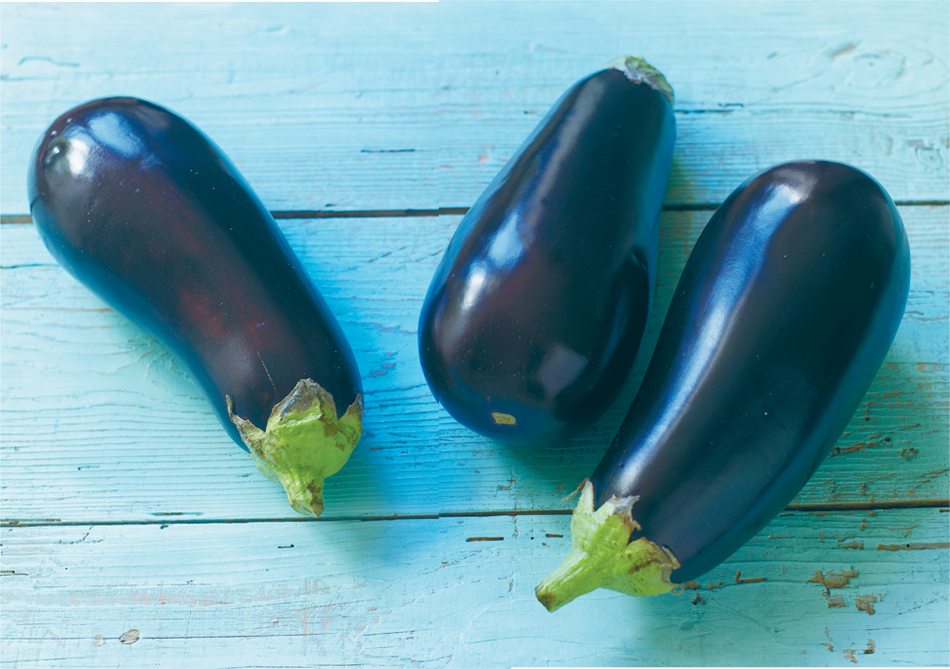
Quick meals to eat on the move, snacks to rustle up in an instant and light dishes to whet the appetite in anticipation of the main course – that’s what this chapter is about.
You’ll find some stunning first courses that are perfect for a special occasion meal or weekend dinner, followed by deliciously simple bruschetta and crostini, then plenty of lunch-box sandwiches and wraps for kids and adults alike. If you’re short on time, try the tasty savouries on toast and super-quick ciabatta or pitta pizzas. Finally, wash it all down with fresh peppermint tea or a nutritious smoothie.
First courses
Antipasto salad
A colourful Italian-style first course.
SERVES 6
225g (8oz) button mushrooms
2 tbsp olive oil
1 small red pepper
2 tsp wine or cider vinegar
salt and freshly ground black pepper
1 bunch of radishes
bunch of spring onions
2 heads of chicory
cucumber
6 tomatoes
4 hardboiled eggs
175g packet of chargrilled artichoke hearts, from the deli
175g packet of sliced roasted peppers, from the deli
12 black olives, or your favourite olives, to garnish
vinaigrette, to serve
Wash and slice the mushrooms; fry lightly in 1 tablespoon of the oil for 5 minutes, then leave to cool.
Slice the red pepper very thinly, discarding the seeds. Place on a flat dish and sprinkle with the remaining oil and wine or cider vinegar. Season with salt and pepper. If possible, leave for 1–2 hours to soften.
Wash and trim the radishes and spring onions; slice the chicory lengthways into quarters, and the cucumber, tomatoes and eggs into circles.
Arrange all the ingredients attractively on individual dishes or a large platter, garnish with olives and serve with vinaigrette.
Globe artichoke hollandaise
This is a delightful starter: cooked globe artichokes filled with hollandaise sauce. You pull off the leaves and dip the bases in the sauce, then enjoy the delicious heart. You’ll need finger bowls, and bowls in which to put the discarded leaves after you’ve sucked the flesh from them. It’s best to cook the artichokes ahead of time then gently reheat them just before serving.
SERVES 4
4 globe artichokes, stems removed
a squeeze of lemon juice
blender hollandaise, to serve
Cut the stalks off the artichokes so that they will sit level, then wash them thoroughly under the cold tap. You might like to trim the points off the leaves using scissors, so that they are less sharp; or you could leave them as they are.
Cook the artichokes in a large saucepan of boiling water, with a good squeeze of lemon juice added, for about 45 minutes, or until a leaf will pull off easily. Drain and rinse under cold water to cool quickly.
Open out the leaves to get to the centre of the artichoke, like opening out the petals of a flower. Pull off and discard the central purple cluster of tender leaves. Underneath you will find the fluffy ‘choke’, which is inedible, so you’ll need to scoop this out with a knife or pointed teaspoon, then rinse the artichoke under the cold tap.
Just before you want to serve the artichokes, reheat them in a microwave in a covered container on high for 4–6 minutes, or until heated through, or stand them in a shallow roasting tin or ovenproof dish, cover with foil and reheat in the oven preheated to 180°C (350°F), gas mark 4 for about 15 minutes or until heated through.
Place each artichoke on a warm plate. Spoon the hollandaise sauce into the centre and serve at once.
Aubergine fritters with tomato sauce v
This is one of the simplest ways of preparing aubergines, but one of my favourites, and I think it’s tasty enough to serve as an extra course or light meal on its own.
SERVES 6
450g (1lb) aubergines
plain flour for coating
salt and freshly ground black pepper
olive oil, for shallow-frying
grated Parmesan-style cheese
lemon wedges
watercress
425ml (15fl oz) homemade tomato sauce, soured cream and herb sauce or tartare sauce, to serve
Wash the aubergines and remove the stems, then cut the aubergines into 6mm (¼in) slices and dip them in flour that has been seasoned with salt and pepper.
Just before you want to serve the aubergines, heat a little oil in a frying pan and fry the slices, a few at a time, on both sides, until the outside is crisp and the inside feels tender when pierced with the point of a sharp knife.
As the fritters are ready, put them in a roasting tin lined with crumpled kitchen paper and keep them warm under the grill or in a low oven until they are all ready.
Serve the fritters sprinkled with a little grated Parmesan-style cheese and garnished with wedges of lemon and sprigs of watercress. Serve the sauce separately.
Aubergine and tapenade rolls v
These rolls are easy to make and are wonderful as part of a selection of canapés or tapas, or arranged on individual plates with some yoghurt and green herb dressing, for a starter.
MAKES 24 OR 48 ROLLS
3 large aubergines
6–8 tbsp olive oil
1 quantity of tapenade
a sprig of flat-leaf parsley, to garnish
Heat the grill.
Cut the stalk ends from the aubergines, then cut the aubergines lengthways into slices about 6mm (¼in) thick. (You will probably get 8–10 slices from each aubergine.)
Brush the slices lightly on both sides with oil and place side by side in a single layer on a grill pan; you may have to do them in batches. Grill for about 5 minutes or until pale brown on top, then turn them over and grill the other side until lightly browned and tender when pierced with a sharp knife. Leave to cool.
To make the rolls, spread one of the aubergine slices quite thinly with tapenade, then roll it up firmly like a Swiss roll. Place seam-side down on a serving plate. Continue in this way until you have done all of them. Serve them whole like this or cut each one in half, which makes them easier to eat if you’re serving them as canapés. Garnish parsley sprigs.
VARIATION
Aubergine and hummus rolls v
Use 250g (9oz) bought or homemade hummus instead of the tapenade and include a little chopped coriander in each roll. Garnish with extra coriander.
Aubergine and garlic cheese rolls v
Use 250g (9oz) dairy or vegan cream cheese with garlic and herbs instead of the tapenade. Garnish with parsley.
Avocado and grapefruit salad v
I love this combination of sharp citrus fruit and buttery avocado. The colours are very pretty and fresh-looking, too.
SERVES 6
2 grapefruit
2 oranges
2 avocado
lettuce
1 tbsp chopped mint
Using a serrated knife, and holding the fruit over a bowl, cut, peel and pith the grapefruit and oranges and slice out the segments.
Thinly peel, stone and slice the avocados, and add to the grapefruit and oranges. Pile onto lettuce leaves and serve chilled and sprinkled with chopped mint.
Melon with ginger v
Adding ginger works magic on melons that are not sweet and fragrant enough to be eaten on their own.
SERVES 6
1 honeydew melon
3 pieces of preserved stem ginger, chopped
6 tbsp of the syrup from the preserved ginger
If the melon is really tender (it can be sliced into with a spoon), cut it into six wedges, remove the seeds, spoon the chopped ginger and the syrup over each piece of melon, and serve.
For less-than-perfect melon, slice off the skin, remove the seeds, and cut the flesh into small pieces. Place in a mixing bowl, add the chopped ginger and syrup and stir together. Serve in individual bowls.
VARIATION
Melon with crème de menthe v
A speciality of a friend of mine and, I must admit, I’d never have thought of this combination, but it’s wonderful. Use a melon with white or pale green flesh – again, it’s a fantastic way of cheering up a melon that’s lacking in flavour. Cut the melon into wedges, pour 1–2 tablespoons of crème de menthe over each and garnish with a sprig of fresh mint if you have some.
Marinated mushrooms v
Serve these spicy, piquant mushrooms well chilled, with some bread to mop up the spicy juices.
SERVES 4
450g (1lb) baby button mushrooms
2 tbsp olive oil
2 tsp ground coriander
1 bay leaf
2 garlic cloves, crushed
salt and freshly ground black pepper
2 tbsp lemon juice
chopped fresh flat-leaf parsley, to serve
Wash the mushrooms, halving or quartering any larger ones, then fry them in the olive oil with the coriander, bay leaf and garlic for about 2 minutes, stirring all the time.
Put the mushrooms straight into a large bowl to prevent further cooking, then add the lemon juice and a grinding of black pepper. Cool, then chill the mixture.






